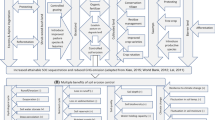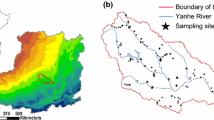Abstract
It has become increasingly well documented that human activities are enhancing the greenhouse effect and altering the global climate. Identifying strategies to mitigate atmospheric carbon dioxide emissions on the national level are therefore critical. Fossil fuel combustion is primarily responsible for the perturbation of the global carbon cycle, although the influence of humans extends far beyond the combustion of fossil fuels. Changes in land use arising from human activities contribute substantially to atmospheric carbon dioxide; however, land use changes can act as a carbon dioxide sink as well. A soil carbon model was built using STELLA to explore how soil organic carbon sequestration (SOC) varies over a range of values for key parameters and to estimate the amount of global soil carbon sequestration from livestock waste. To obtain soil carbon sequestration estimates, model simulations occurred for 11 different livestock types and with data for eight regions around the world. The model predicted that between 1980 and 1995, United States soils were responsible for the sequestration of 444–602 Tg C from livestock waste. Model simulations further predicted that during the same period, global soil carbon sequestration from livestock waste was 2,810–4,218 Tg C. Our estimates for global SOC sequestration are modest in proportion to other terrestrial carbon sinks (i.e. forest regrowth); however, livestock waste does represent a potential for long-term soil carbon gain. SOC generated from livestock waste is another example of how human activities and land use changes are altering soil processes around the world.


Similar content being viewed by others
References
American Society of Agricultural Engineers. (1977). Manure production and characteristics, ASAE Yearbook D, St. Joseph, MI. p. 384.
Batjes, N. H. (2004). Estimation of soil carbon gains upon improved management within croplands and grasslands of Africa. Environment, Development and Sustainability, 6, 133–143. doi:10.1023/B:ENVI.0000003633.14591.fd.
Benne, E. J., Hoglund, C. R., Longnecher, E. D., & Cook, R. L. (1961). Animal manures—what are they worth today? Michigan State University Agriculture Experiment Station Circle Bulletein, 231, 15.
Bernal, M. P., Sanchez-Monedero, M. A., Paredes, C., & Roig, A. (1998). Carbon mineralization from organic wastes at different composting stages during their incubation with soil. Agriculture Ecosystems & Environment, 69, 175–189. doi:10.1016/S0167-8809(98)00106-6.
Broeker, W. S., Takahashi, T., Simpson, H. J., & Peng, T. H. (1979). Fate of fossil fuel carbon dioxide and the global carbon budget. Science, 206, 409–418. doi:10.1126/science.206.4417.409.
Changsheng, L., Frolking, S., & Harris, R. (1994). Modeling carbon biogeochemistry in agricultural soils. Global Biogeochemical Cycles, 8, 237–254. doi:10.1029/94GB00767.
Conant, R. T., Paustian, K., & Elliot, E. T. (2001). Grassland management and conversion into grassland: Effects of soil carbon. Ecological Applications, 11(2), 343–355. doi:10.1890/1051-0761(2001)011[0343:GMACIG]2.0.CO;2.
Correll, D. L., Jordan, T. E., & Weller, D. E. (1995). Animal waste and the land-water interface. New York, NY: Lewis Publishers.
Costanza, R., Duplisea, D., & Kautsky, U. (1998). Ecological modelling and economic systems with STELLA. Ecological Modelling, 110, 1–4. doi:10.1016/S0304-3800(98)00099-4.
Delgado, C. L., Courbois, C. B., & Rosegrant, M. W. (1998). Global food demand and the contribution of livestock as we enter the new millennium. Washington, DC: International Food Policy Research Institute.
Dumanski, J. (2004). Carbon sequestration, soil conservation, and the Kyoto Protocol: summary of implications. Climatic Change, 65, 255–261. doi:10.1023/B:CLIM.0000038210.66057.61.
Fan, S., Gloor, M., Mahlman, J., Pacala, S., Sarmiento, J., Takahashi, T., et al. (1998). A large terrestrial carbon sink in North America implied by atmospheric and oceanic carbon dioxide data and models. Science, 282, 442–446. doi:10.1126/science.282.5388.442.
Fellman, J. B. (2000). Simulation of soil carbon sequestration via livestock waste. MS thesis, Env. Science and Regional Planning Program. Pullman, WA: Washington State University.
Gao, G., & Chang, C. (1996). Changes in CEC and particle size distribution of soils associated with long-term annual applications of cattle feedlot manure. Soil Science, 161(2), 115–120. doi:10.1097/00010694-199602000-00006.
Gilmour, C. M., Broadbent, F. E., & Beck, S. M. (1977). Soils for management of organic wastes and waste waters. Madison, WI: American Society of Agronomy, Inc.
Golueke, C. G. (1972). Composting: A study of the process and its principles. Emmaus: Rodale Press.
Houghton, R. A. (2003). Why are estimates of the terrestrial carbon cycle balance so different? Global Change Biology, 9, 500–509. doi:10.1046/j.1365-2486.2003.00620.x.
Houghton, R. A., Boone, R. D., Fruci, J. R., Hobbie, J. E., Melillo, J. M., Palm, C. A., et al. (1987). The flux of carbon from terrestrial ecosystems to the atmosphere in 1980 due to changes in land use: Geographic distribution of the global flux. Tellus Series B, 39, 122–139.
Houghton, R. A., Davidson, E. A., & Woodwell, G. M. (1998). Missing sinks, feedbacks, and understanding the role of terrestrial ecosystems in the global carbon budget. Global Biogeochemical Cycles, 12, 25–34. doi:10.1029/97GB02729.
IPCC (Intergovernmental Panel on Climate Change). (1997). IPCC guidelines for national greenhouse gas inventories: reference manual.
Jenkinson, D. S. (1991). The Rothamsted long-term experiments: Are they still of use. Agronomy Journal, 83, 2–10.
Jenkinson, D. S., & Rayner, J. H. (1977). The turnover of soil organic carbon matter in some of the Rothamsted classical experiments. Soil Science, 123(5), 298–305. doi:10.1097/00010694-197705000-00005.
Joos, F., Meyer, R., Bruno, M., & Leuenberger, M. (1999). The variability in the carbon sinks as reconstructed for the last 1000 years. Geophysical Research Letters, 26, 1437–1440. doi:10.1029/1999GL900250.
Liang, B. C., Gregorich, E. G., & MacKenzie, A. F. (1996). Modeling the effects of inorganic and organic amendments on organic matter in a Quebec soil. Soil Science, 161(2), 109–114. doi:10.1097/00010694-199602000-00005.
Loehr, R. C. (1974). Agricultural waste management: Problems, processes and approaches. New York, NY: Academic Press.
Loehr, R. C. (1984). Pollution control for agriculture. New York, NY: Academic Press, Inc.
Massari, S. (2003). Current food consumption patterns and global sustainability. Discussion paper presented at the United Nations Environmental Program Sustainable Agri-Food Production and Consumption Forum.
Merkel, J. A. (1981). Managing livestock waste. Westport, Connecticut: The AVI Publishing Company, Inc.
NCSU (North Carolina State University). (1990). Livestock waste characteristics. Raleigh, North Carolina: Biology and Agricultural Engineering Department.
Nyakatawa, E. Z., Reddy, K. C., & Sistani, K. R. (2001). Tillage, cover cropping, and poultry litter effects on selected soil chemical properties. Soil & Tillage Research, 58, 69–79. doi:10.1016/S0167-1987(00)00183-5.
Ogle, S. M., Breidt, F. J., Eve, M. D., & Paustian, K. (2003). Uncertainty in estimating land use and management impacts on soil organic carbon storage for US agricultural lands between 1982 and 1997. Global Change Biology, 9, 1521–1542. doi:10.1046/j.1365-2486.2003.00683.x.
Pacala, S., & Socolow, R. (2004). Stabilization wedges: Solving the climate problem for the next 50 years with current technologies. Science, 305, 968–972. doi:10.1126/science.1100103.
Parton, W. J., Schimel, D. S., Cole, C. V., & Ojima, D. S. (1987). Analysis of factors controlling soil organic matter levels in Great Plains Grasslands. Soil Science Society of America Journal, 51, 1173–1179.
Pimentel, D., & Pimentel, M. (2003). Sustainability of meat-based and plant-based diets and the environment. The American Journal of Clinical Nutrition, 78(suppl), 660s–663s.
Post, W. M., & Kwon, K. C. (2000). Soil carbon sequestration and land-use change: Processes and potential. Global Change Biology, 6, 317–327. doi:10.1046/j.1365-2486.2000.00308.x.
Robertson, G. P., Paul, E. A., & Harwood, R. R. (1999). Greenhouse gases in intensive agriculture: Contributions of individual gases to radiative forcing of the atmosphere. Science, 289, 1922–1925. doi:10.1126/science.289.5486.1922.
Safley, L. M., Casada, M. E., Woodbury, J. W., & Roos, K. F. (1992). Global methane emissions from livestock and poultry manure. U.S. Env. Protection Agency, EPA/400/1-91/048.
Schlesinger, W. H. (1997). Biogeochemistry: An analysis of global change (pp. 155–160). London: Academic Press.
Schlesinger, W. H. (1999). Carbon and agriculture: Carbon sequestration in soils. Science, 284, 2095. doi:10.1126/science.284.5423.2095.
Schuman, G. E., Reeder, J. D., Manley, J. T., Hart, R. H., & Manley, W. A. (1999). Impact of grazing management on the carbon and nitrogen balance of a mixed-grassland rangeland. Ecological Applications, 9(1), 65–71. doi:10.1890/1051-0761(1999)009[0065:IOGMOT]2.0.CO;2.
Singh, B. R., & Lal, R. (2005). The potential of soil carbon sequestration through improved management practices in Norway. Environment Development and Sustainability, 7, 161–184. doi:10.1007/s10668-003-6372-6.
Smith, L. W. (1973). Symposium: Processing agricultural and municipal wastes. Westport, Connecticut: Avi. Publishing Company, Inc.
Smith, P., & Powlson, D. S. (2000). Considering manure and carbon sequestration. Science, 287, 428–429. doi:10.1126/science.287.5450.54.
Smith, P., Powlson, D. S., Glendining, M. J., & Smith, J. U. (1997). Potential for carbon sequestration in European soils: preliminary estimates for five scenarios using results from long-term experiments. Global Change Biology, 3, 67–79. doi:10.1046/j.1365-2486.1997.00055.x.
Smith, P., Powlson, D. S., Smith, J. U., Falloon, P., & Coleman, K. (2000). Meeting Europe’s climate change commitments: quantitative estimates of the potential for carbon mitigation by agriculture. Global Change Biology, 6, 525–539. doi:10.1046/j.1365-2486.2000.00331.x.
Smith, P., & Smith, T. J. F. (2000). Transport carbon costs do not negate the benefits of agricultural carbon mitigation options. Ecology Letters, 3, 379–381. doi:10.1046/j.1461-0248.2000.00176.x.
Sommerfeldt, T. G., & Chang, C. (1987). Soil water properties as affected by twelve annual applications of feedlot manure and different tillage practices. Soil Science Society of America Journal, 51, 7–9.
Sommerfeldt, T. G., Chang, C., & Entz, T. (1988). Long-term annual manure applications increase soil organic matter and nitrogen, and decrease carbon to nitrogen ratio. Soil Science Society of America Journal, 52, 1668–1672.
Tans, P. P., Fung, I. Y., & Takahashi, T. (1990). Observational constraints on the global atmospheric carbon dioxide budget. Science, 247, 1431–1438. doi:10.1126/science.247.4949.1431.
USDA. (1930–2005). Agricultural statistics 1930–2005, United States Department of Agriculture, U.S. Government Printing Office, Washington D.C., 20402.
Wackernagel, M., Schulz, N. B., Deumling, D., Linares, A. C., Jenkins, M., Kapos, V., et al. (2002). Tracking the ecological overshoot of the human economy. Proceedings of the National Academy of Sciences of the United States of America, 99, 9266–9271. doi:10.1073/pnas.142033699.
Acknowledgements
The authors would like to thank Kent Keller and Andy Ford for their guidance and insightful comments on an earlier draft of this manuscript. This research was partially supported by a Lane Fellowship in Environmental Science and Regional Planning, Washington State University.
Author information
Authors and Affiliations
Corresponding author
Additional information
Readers should send their comments on this paper to: BhaskarNath@aol.com within 3 months of publication of this issue.
Appendix A
Appendix A
Countries included in this study and considered climatic exceptions. Information on temperature and available moisture factors was obtained from Safley et al. (1992)
North America
Canadaa
United States
Western Europe
Austria
Belgium
Denmark
Finlanda
France
West Germany
Greece
Ireland
Italy
Netherlands
Norwaya
Portugal
Spain
Swedena
Switzerland
UK
East Europe
Albania
Bulgaria
Czechoslovakiaa
East Germany
Hungarya
Polanda
Romaniaa
Soviet Uniona
Yugoslavia
Oceania
Australiab
Fiji
New Caledonia
New Zealand
P. New Guinea
Vanuatu
Africa
Angola
Benin
Botswanab
Burkina Fasob
Burundi
Cameroon
Central African Republic
Chadb
Cote d’lvore
Ethiopiab
The Ghambia
Ghana
Guinea
Guinea-Bissau
Kenyab
Lesotho
Madagascar
Malawi
Malib
Mauritaniab
Mozambique
Namibiab
Nigerb
Nigeria
Rwanda
Senegal
Sierra Leone
Somaliab
South Africab
Swaziland
Tanzania
Togo
Uganda
Zaire
Zambia
Zimbabwe
Latin America
Argentina
Bolivia
Brazil
Chile
Columbia
Costa Rica
Cuba
Dominican Republic
Ecuador
El Salvador
Guatemala
Guyana
Haiti
Honduras
Jamaica
Mexico
Nicaragua
Panama
Paraguay
Peru
Puerto Rico
Uruguay
Venezuela
Near East & Mediterranean
Afghanistanb
Algeriab
Egyptb
Iranb
Iraqb
Israel
Jordanb
Kuwait
Libyab
Morocco
Omanb
Saudi Arabiab
Sudanb
Syriab
Tunisiab
Turkey
Yemen Arab Republicb
Asia & Far East
Bangladesh
Bhutan
Burma
China
India
Indonesia
Japan
Kampuchea
North Korea
South Korea
Laos
Malaysia
Mongoliab
Nepal
Pakistanb
Philippines
Sri Lanka
Thailand
Vietnam
a Countries considered climatic exceptions (cold)
b Countries considered climatic exceptions (arid/semiarid)
Rights and permissions
About this article
Cite this article
Fellman, J.B., Franz, E.H., Crenshaw, C.L. et al. Global estimates of soil carbon sequestration via livestock waste: a STELLA simulation. Environ Dev Sustain 11, 871–885 (2009). https://doi.org/10.1007/s10668-008-9157-0
Received:
Accepted:
Published:
Issue Date:
DOI: https://doi.org/10.1007/s10668-008-9157-0




